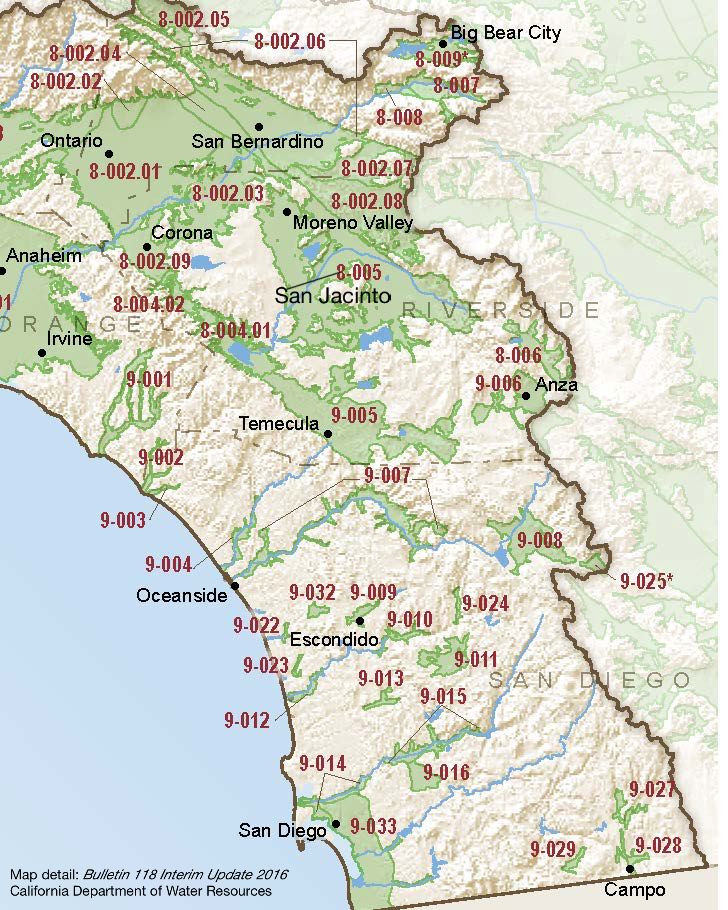San Jacinto
Statistics
- Basin Name
- San Jacinto
- Basin Number
- 8-005
- SGMA Basin Priority
- High
- Critically Overdrafted
- No
- Hydrologic Region Name
- South Coast
- Counties
- Riverside
At-A-Glance
Located in California’s South Coast hydrologic region, the San Jacinto subbasin is 158,534.44 acres in size. This High priority basin is home to an estimated 467,751 people (2010 value). It has approximately 1950 wells, of which approximately 61 are water supply wells. Groundwater accounts for approximately 42 percent of the basin’s water supply.

Basin Notes
2003: Bulletin 118
2013: Hemet San Jacinto Stipulated Judgment
2014: CASGEM basin prioritization – high. Comment: Basin is in overdraft (MWD). Groundwater quality issues documented in DWR B‐118. Pumping has increased some contaminant distribution in the basin.
2016: basin boundary modification
Revised basin boundary description
From An Evaluation of California’s Adjudicated Groundwater Basins by Langridge et al, UC Davis (2016): “Groundwater problems in the San Jacinto Basin were first addressed by the court in a 1954 judgment that allocated pumping rights for the Fruitvale Mutual Water Company in the upper San Jacinto Basin. Declining groundwater levels persisted into the 1970s, and local water purveyors attempted to develop a groundwater management plan to address the declines. Eastern Municipal Water District (EMWD), which had acquired the Fruitvale Company in 1972, worked with the water purveyors in the 1990s to implement an AB 3030 groundwater management plan for the West San Jacinto Groundwater Management Area. In 2001, a Memorandum of Understanding between the Department of Water Resources (DWR) and local agencies required a water management plan for the Hemet/San Jacinto Groundwater Management Area, the eastern portion of the San Jacinto Basin, and a plan was released in 2007. At the same time, the Soboba Band of Luiseño Indians, negotiating with the local agencies to specify their groundwater rights from the Hemet/San Jacinto Groundwater Management Area, also pushed for a management plan. These negotiations culminated in the 2008 Soboba Settlement Agreement Act that established their water rights. A 2013 stipulated judgment allocated pumping rights for public water agencies, provided for water rights outlined in the Soboba Settlement Agreement, incorporated the Water Management Plan, and mandated a Watermaster.”
2018: Draft basin priority – high. Comments:
- Groundwater level – 1) CASGEM/WDL/GWIDS: Longterm hydrographs show groundwater level decline. Source: DWR 2) The Hemet/San Jacinto Groundwater Management Area monitors around 200 wells twice a year, but report has no hydrographs and does not summarize long-term history. There is a Basin Storage graph that shows delining storage. Source: Hemet/San Jacinto Groundwater Management Area 2015 Annual Report 3) Historically, extraction in excess of recharge has resulted in lowered groundwater levels and altered directions of groundwater flow. Source: Hemet/San Jacinto Groundwater Management Plan.
- Subsidence – 1) Subsidence related to tectonic deformation and aquifer compaction; reported subsidence of 2.3 feet between 1939 and 1959 Lofgren (1976) measured compaction of aquifer materials with a 377-m deep extensometer from 1970 to 1974 and concluded that inelastic compaction of aquifer materials in the depth range of the extensometer amounted to about 1 cm /yr (0.04 ft/yr) and that tectonic subsidence amounted to 0.3-0.6 cm/yr (0.1-0. 2 in/yr). That is, most permanent subsidence (70-80 percent) resulted from groundwater withdrawal, with the remainder from tectonic downwarping of the valley. Source: Land subsidence and aquifer-system compaction in the San Jacinto Valley, Riverside County, California – A progress report
Reference note: 33.13% of basin is adjudicated
2019: Basin boundary modification approval and denial. Per DWR: “The basin boundary modification request includes the revision of both internal and external boundaries. The request contains six components that utilize qualified geologic maps, alluvial thickness, borehole analysis, and topographic gradients to better define the boundaries of the of the basin. One letter of support is associated with the request. One public comment (neutral) was submitted on the drat decision to approve the modification. Five of the six components of the request meet all regulatory requirements. The removal of the Lake Perris area is denied and not supported by sufficient geologic evidence. The agency did not sufficiently demonstrate that the Lake Perris area is hydrologically disconnected from San Jacinto Basin.” Phase 2 draft priority status: high.
2021: November 17 – GSP submitted to DWR
